The authors are affiliated with SightLine Ophthalmic Consulting, which is committed to helping vision care professionals through education and training to elevate their patient care and business revenue. The authors report that this content was developed independently without commercial bias. Sightline Partners have consulted with Visionix, Essilor Instruments, and Johnson & Johnson Vision.
There are 128 millionpresbyopes in the unitedstates,1-5 representing the largest patient segment in our profession. Hence, it is imperative that we understand advanced progressive lens designs and how to prescribe them for our presbyopic patients’ visual needs. The ultimate goal is to enhance patient satisfaction with their visual experience and minimize the occurrence of progressive addition lens (PAL) returns and redos.
Let’s discuss what we consider to be the 4 fundamental DNA concepts of each PAL design. These concepts will, in turn, help us understand and predict the lens performance and the patient’s visual experience.
• Surfacing
• Design
• Off-axis aberrations
• Vertical power change
1. Surfacing - Is It A Traditional Or Freeform Surfaced Lens?
Traditional Surfacing
A progressive lens has different powers for distance and near prescriptions, and ideally, each power should have a different base curve (BC) to provide optimal optics.6 Based on the patient’s distance and add prescription, the lab uses a table to select a lens with a specific base curve. The lab must stock many BC lenses (or forms) for different prescription combinations. Patients whose prescriptions correspond closely to a standard base curve enjoy the best visual performance. However, if a patient’s prescription falls between the desired forms, the lab must choose the next best form, and the outcome will not be as visually ideal.
Freeform Digital Surfacing
Here, a software program analyzes and computes a surface profile across the lens point by point to best accommodate the patient’s prescription. The result is excellent performance across all prescription ranges. The difference between an older lens and the latest freeform progressive lens lies in extensive research and development, computerization, and manufacturing equipment. The end product results in a more natural visual experience by addressing the following issues:
• The higher-order aberrations are decreased in daylight and low-light conditions to create a wider field of view at night and during the day.
• Each prescription is personalized by considering the patient’s position of wear measurements, lifestyle characteristics, age, add power, and pupil size.
• The software adjusts for the differences in eye center of rotation for emmetropes, myopes, and hyperopes. It optimizes binocular function by providing similar images to each eye in all directions of gaze.
• For today’s digital device closer working distance, the intermediate and near zones are wider, with decreased off-axis aberrations.
Finally, the ease of adaptation for all of our progressive lens wearers is essential to our success as eyecare providers.
What kind of equipment is needed to surface PALs?
You can use a traditional lap surfacing machine to make traditional-form lenses. For freeform surfacing, the software program must guide a digital surfacer. The same digital surfacer can be used for standard lenses (non-freeform lenses), in which case the prescription will be surfaced with more accuracy but will not be software guided or compensated.
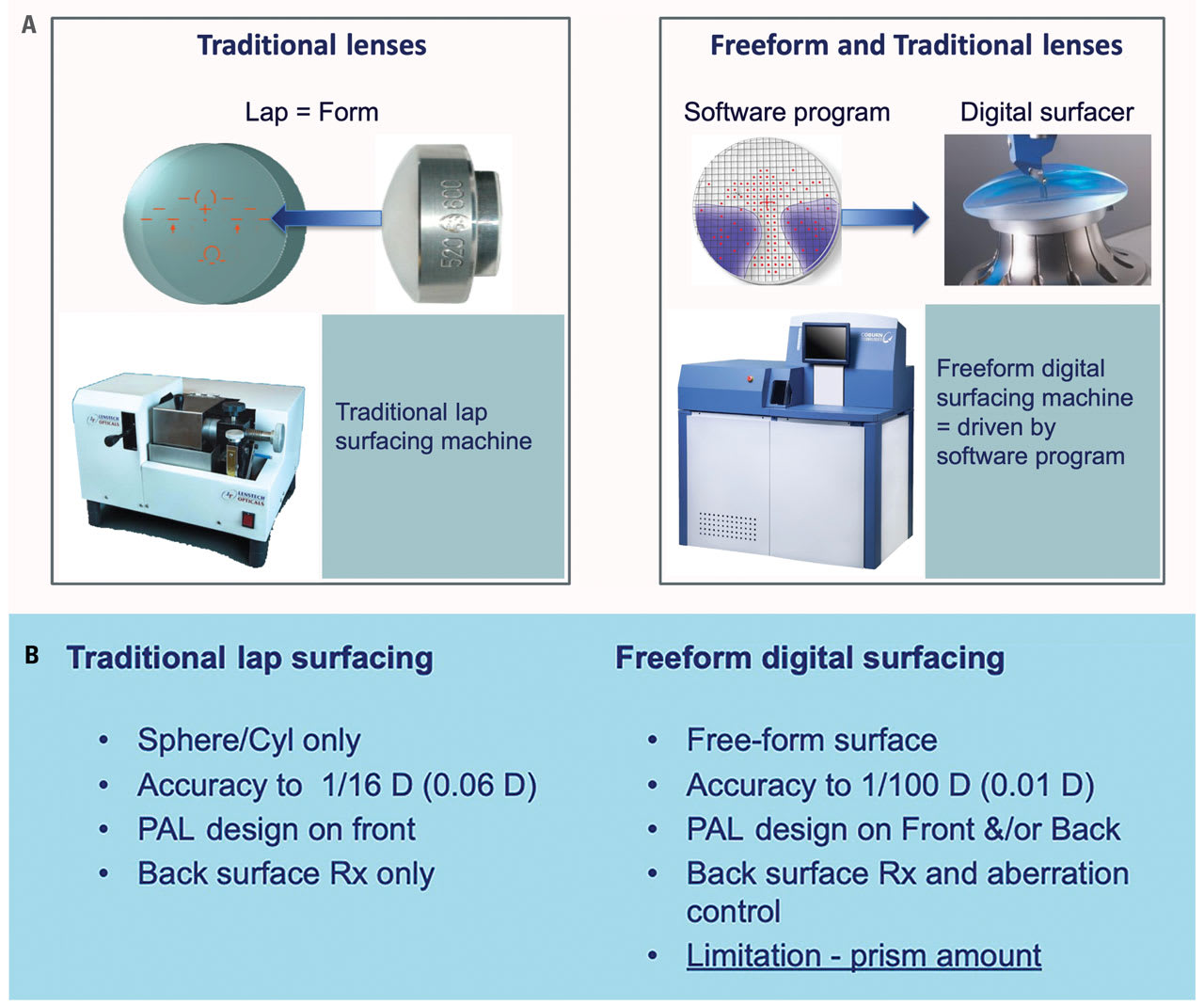
Above, panel A shows surfacing equipment—Traditional Surfacing vs. Digital Freeform Surfacing. Panel B is a summary of Traditional and Freeform Surfacing capabilities.
One limitation with freeform surfacing software is the amount of prism. Generally, a max of 3-5 prism diopters per eye is achievable, but this amount varies for different lens designs, so you need to check with your lab.
The difference in lens designs between major ophthalmic manufacturers is the companies’ software programs, which drive the digital surfacing machine to create the final product. The manufacturing process is the same for all; the end product will differ based on what the manufacturer’s software tells the surfacer to do. Freeform technology software continues to evolve and become more sophisticated with newer designs. Think about how the iPhone continues to develop from the original to the latest iPhone model: the older phones are still usable, but the newer phones offer us so much more technology and functionality.
2. Design - Dual Surface (DS) vs All Back Surface (ABS)
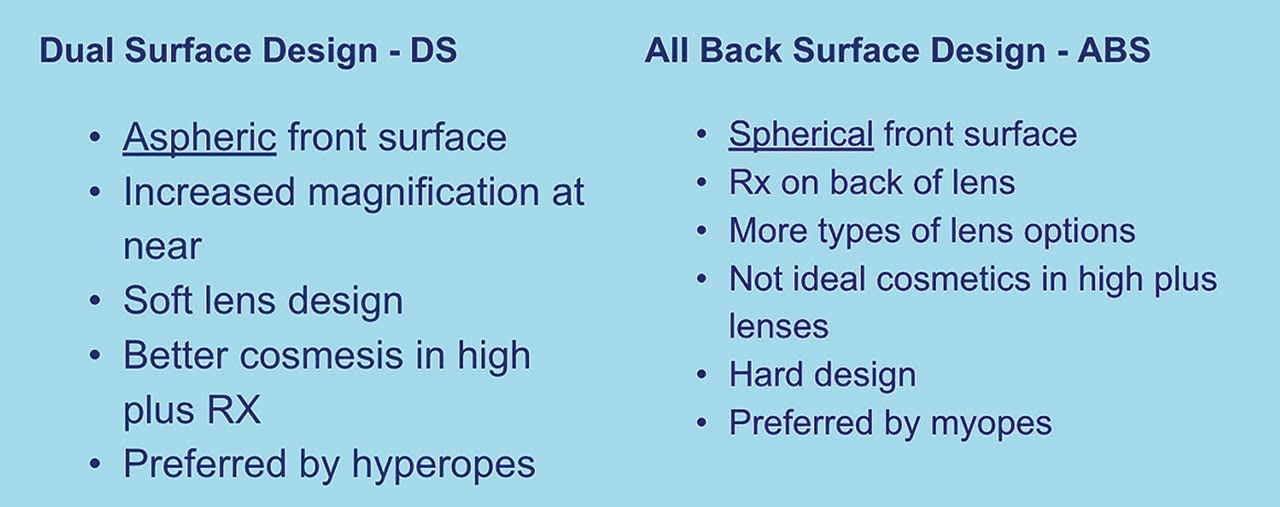
PAL design pertains to where the prescription is placed. There are 2 main configurations:
• Dual surface (DS) design
• All back surface (ABS) design
With DS design, the prescription is partly on the back and partly on the front of the lens. The front of the lens surface is aspheric, continuously steepening the base curve from top to bottom. The steeper curve in the near zone is cosmetically better for high plus prescriptions, and it increases magnification at near, which is why hyperopes usually prefer it. DS is found in soft aberration PAL designs, a DNA concept explained later in the article.
ABS design uses a single-vision (SV) lens blank and places the prescription at the back of the lens, so the lens clock along the front will read the same base curve from top to bottom. The benefit of using a SV lens blank is that it allows for more lens add-ons and options, such as polarization, photochromatics, and different indices of refraction. ABS is generally preferred by myopes and is found in hard aberration PAL designs (described next). Remember that high hyperopic prescriptions can look cosmetically worse in an ABS design than in a dual-surfaced design because the BC remains the same from top to bottom. Also, because it is easier to use SV lens blanks, online vendors tend to use ABS designs for their PALs.
3. Off Axis Aberration - Hard vs Soft Aberration Control
Aberration patterns in PALs can be soft, where the unwanted cylinder is distributed broadly across the lens, or hard, where it is concentrated below the 180° line.
Soft design has widely spaced aberration areas distributed up into the distance periphery of the lens, resulting in narrowing of the distance portion with minimal impact on the intermediate and near zones. Soft designs are typically found in DS configurations and are favored by hyperopes.
In hard design, the aberration areas are pushed below the 180° line, creating higher concentrated areas of aberration in the lower part of the lens and narrowing the intermediate and near zones. This design is found in ABS surface lenses and is generally preferred by myopes.
The electronic progressive identifier catalog (EPIC) is the industry’s online guide for identifying lens designs based on their marked engraving7. It offers information on the 4 PAL DNA components in a single place, listing the surfacing method (a), the lens design (b) (which will dictate the off-axis aberration), and the minimum fitting height (c).
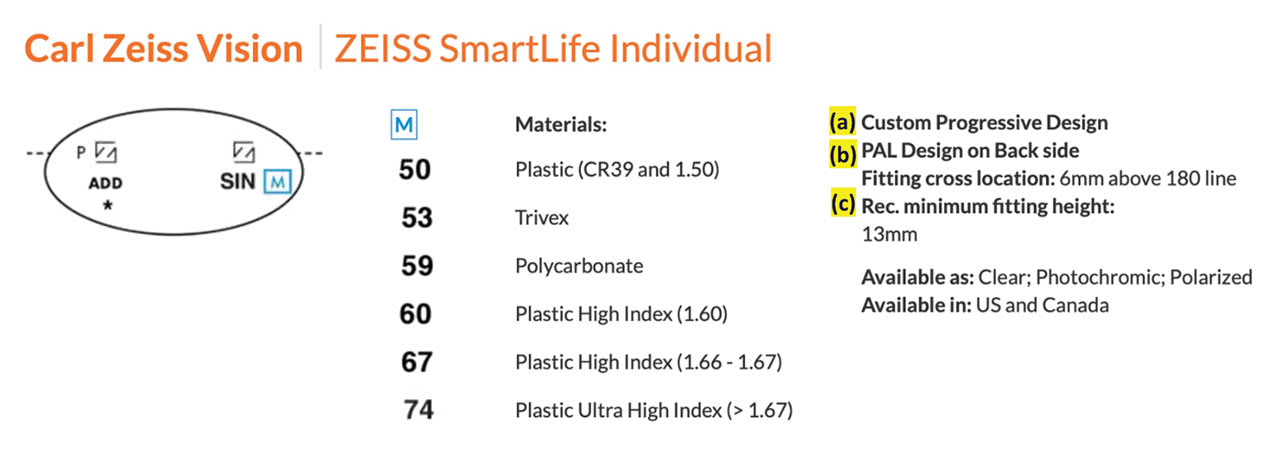
4. Vertical Power Change
Vertical power change refers to the corridor, which is the transition from distance to near vision within the lens. There are 3 concepts to review, and each plays a crucial role in how a lens is crafted and how it will perform for the patient.
• Minimum fitting height
• Variable corridor
• Fixed corridor
Minimum Fitting Height
All progressives have minimum fitting height specifications, meaning that the patient will be looking through 85% of the add at that fitting height. Therefore, to guarantee viewing through 100% of the add, it is best to fit a patient into a frame at least 2 mm greater than the minimum height. All standard progressives follow this concept, and that is all we needed to know before digital freeform lenses came along.
Variable Corridor
All digital freeform lenses still have a minimum fitting height requirement, with a few corridor lengths built into the software program. This specification means the software will choose the longest workable corridor based on the fitting height. The corridor length will be longer on larger fitting heights and shorter on shorter fitting heights. However, there is a limit to the length of the corridor within the software to prevent the eye from having to look too far down in the lens. You still have to follow the minimum fitting height rule. The variable corridor concept is found in DS soft and ABS hard freeform PAL designs. Furthermore, with freeform surfacing capabilities, manufacturers are able to create “task-specific” or prioritized software driven lens designs. These lens options allow the prescriber to manage the length of the variable corridor.
For example, Zeiss SmartLife Individual has 3 corridor lengths in the software, allowing the provider to customize for near, intermediate, or balanced activities. If you order a Zeiss SmartLife Individual lens design, the software will select the longest workable corridor based on the fitting height. Or you can customize the lens by choosing Zeiss SmartLife S (S is for short) to create a larger and wider near area, or you can choose an M (Medium) corridor or an L (Long) corridor, which will concentrate more on the distance and intermediate zones.
Variable corridor lengths in freeform lenses could be a reason for some of your patient nonadapts. For example, suppose your patient with the same Rx and same progressive lens changes their frame from a small B dimension to a larger frame. In that case, this will change from a shorter corridor to a longer corridor design (chosen by the software), and the patient must learn to look deeper in the frame when reading. This factor can also be important for the first time presbyope with a low add prescription, when you want the patient looking through their low add higher up in the lens. The solution for these nonadapts is to refit the patient into a lens designed to concentrate on near tasks or a lens where you can control the corridor length.
Fixed Corridor
Fixed corridor lenses are available with multiple corridor lengths. For example, the Shamir Autograph Intelligence has 11-, 13-, 15-, and 18-mm corridors, and you must specify the length you want when ordering this lens. The shorter corridor lengths cover larger areas of reading material. Most fixed corridor lens designs may have a variable option, called V or VL, where you can allow the software to choose the longest workable corridor, as in the variable corridor concept.
The general rule for a fixed corridor design is below.
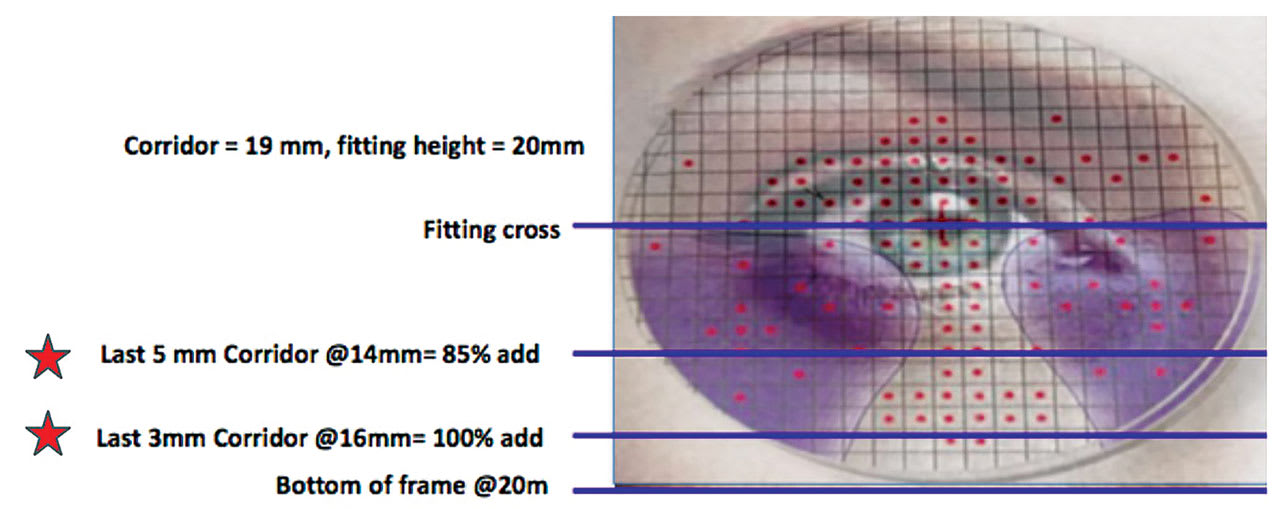
Eighty-five percent of the add is reached at the last 5 mm of the selected corridor length,with 100% of the add reached at the last 3 mm of the selected corridor length. As an aside, we calculated how much clear vision a patient obtains for every millimeter on the lens. At 40 cm of working distance, 1 mm on the lens projects about 1.2 inches of clear vision onto a page or a digital device, and for a computer or 67 cm of working distance, each millimeter on the lens should project 2 inches of clear viewing area.
In summary, there are two ways to fit a fixed corridor lens:
You can select V or VL, allowing the software to choose the longest workable corridor or select the corridor length using the following method: subtract 3 mm from the fitting height measurement, and choose the corridor length option that aligns with the answer.
For example, with a 20-mm fitting height - 3 = 17, we can choose a 17-mm fixed corridor, which, at 40 cm, should provide our patient with a bit more than 7 inches of clear near vision. Or you can order an even shorter corridor to provide the patient with a larger, clear near area.
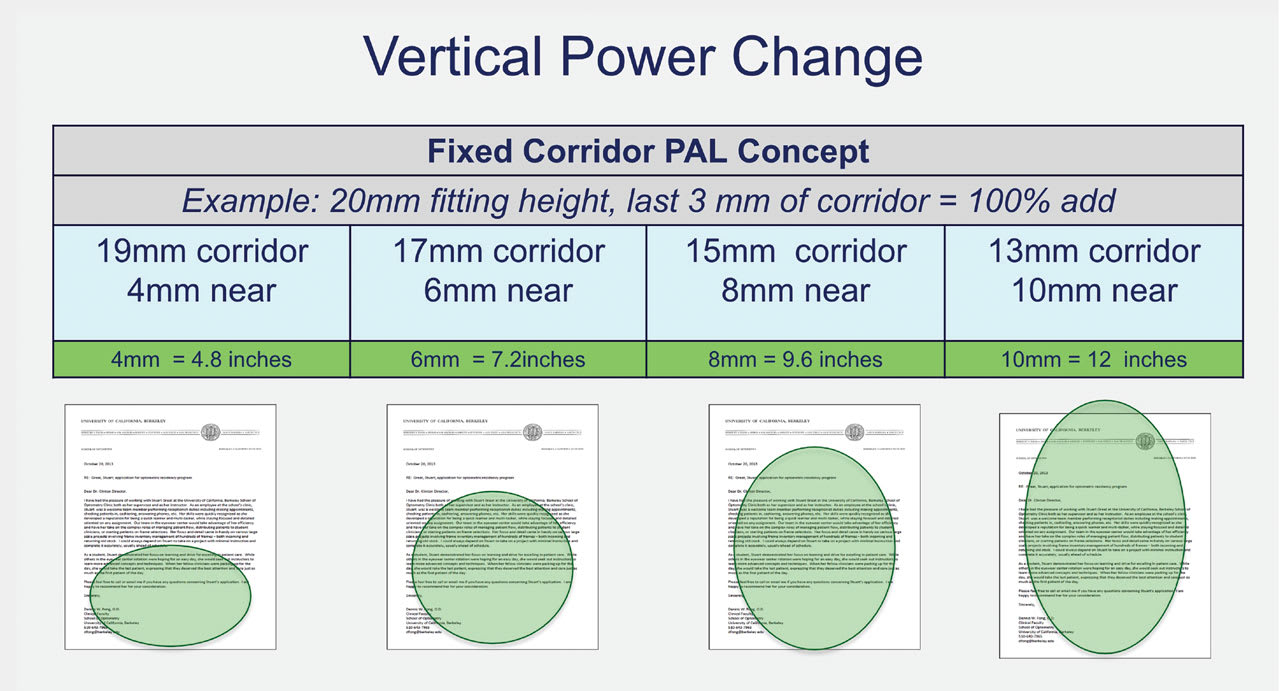
Practitioners and staff can break down each manufacturer’s freeform lens designs into the 4 DNA components and clearly understand how to prescribe the lenses for their patients’ visual needs or troubleshoot adaptation problems. For example, Varilux XR is a dual-surfaced, soft lens design with a variable corridor in the software program. Zeiss SmartLife Individual is an all-back surface, hard lens design with variable corridors in the software program, with an option to select a short, medium, or long corridor.
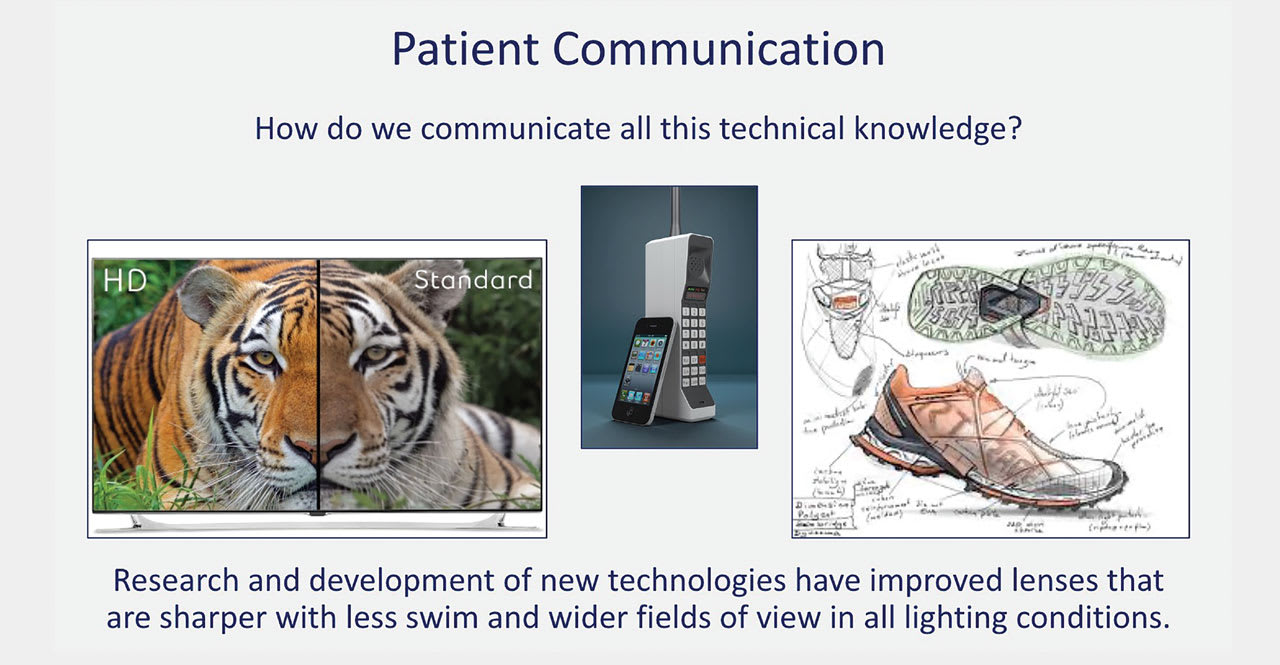
How do we communicate the benefits of new lens technology to a first time PAL wearer or a patient wearing an older lens design? Using the latest research, development, and technology, lens manufacturers have created lenses with less side blur, translating into wider and clearer vision at all distances. These new designs improve nighttime vision and reduce the magnification effect when looking down while walking. We can compare the traditional freeform progressive lenses to the upgrade from basic sneakers to high-performance running shoes, illustrating the importance of tailored fit and performance. Similarly, relating the improvements in lens technology to the evolution from standard to high-definition televisions can help patients to understand the enhanced clarity they will experience.
Conclusion
By incorporating this knowledge into practice, optometrists can effectively navigate the complexities of progressive lens prescriptions, ensuring that each patient receives the optimal lens for their unique visual needs. Continuous education in progressive lens technology will be a cornerstone in reducing PAL non-adapts, enhancing patient satisfaction, and ultimately contributing to the success of practices specializing in presbyopic care.
References
1.Optometric Clinical Practice Guideline: Care of the Patient with Presbyopia. American Optometric Association; 2011. Accessed April 25, 2024. https://sdeyes.org/docs/CPG-17.pdf
2. Zebardast N, Friedman DS, Vitale S. The prevalence and demographic associations of presenting near-vision impairment among adults living in the United States. Am J Ophthalmol. 2017;174:134-144.
3. 2014 national population projection tables. US Census Bureau website. Accessed April 25, 2024. https://www.census.gov/data/tables/2014/demo/popproj/2014-summary-tables.html
4. Searing L. The big number: millennials to overtake boomers in 2019 as largest U.S. population group. Washington Post website. Accessed April 25, 2024. https://www.washingtonpost.com/national/health-science/the-big-number-millennials-to-overtake-boomers-in-2019-as-largest-us-population-group/2019/01/25/a566e636-1f4f-11e9-8e21-59a09ff1e2a1_story.html
5. Dimock M. Defining generations: where millennials end and Generation Z begins. Pew Research Center website. Accessed April 25, 2024. https://www.pewresearch.org/short-reads/2019/01/17/where-millennials-end-and-generation-z-begins/
6. Cline D, Hoffstetter HW, Griffin JR. Dictionary of Visual Science, Third Edition, 1980, pp. 150-151.
7. Electronic progressive identifier catalog. The Vision Council website. Accessed April 25, 2024. https://epic.thevisioncouncil.org/












